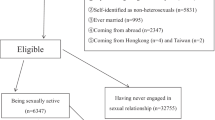Summary
In order to ascertain prevalence rate of premarital sexual intercourse, unintended pregnancy and abortion, and evaluate associated factors of unintended pregnancy among undergraduates from all over China, the representative sample of unmarried undergraduates was obtained by using a multi-stage, stratified, probability cluster design, and data were collected by using a survey questionnaire. 62 326 available responders were gained. 11.6% of them acknowledged having experiences of premarital sexual intercourse (standardized prevalence rate of sexual intercourse was 13.8%). 31.5% of students active in premarital sex acknowledged undergoing unintended pregnancy. 76.2% of pregnant students selected abortion to end it. Of students active in premarital sex, 46.2% used contraception at the first sexual intercourse, 28.2% replied “always” using contraception in sexual intercourse. The rate of using condoms, oral contraceptives (OCs), and withdrawal among students who had used contraception was 52.0%, 31.0%, and 27.2% respectively. “No preparation for sex” (40.3%), “pleasure decrement” (32.1%), “won’t-be-pregnancy in occasional sexual intercourse” (30.2%) were their common excuses for using no contraception. The identified risk factors for unintended pregnancy among students active in premarital sex by multivariate analysis were as follows: having no steady lover [having no steady lover vs having a steady lover: odds ratio (OR), 1.875; 95% confidence interval (CI), 1.629–2.158], unaware of the course of conception (unaware vs aware: OR, 2.023; 95% CI, 1.811–2.260), considering abortion not endanger women’s physical and mental health (no endangerment vs endangerment: OR, 2.659; 95% CI, 2.265–3.121), nonuse of contraception (never use vs always use: OR, 1.682; 95% CI, 1.295–2.185). Medical students were not less likely to experience an unintended pregnancy than nonmedical students (OR, 1.111; 95% CI, 0.906–1.287). The substantial proportion of unintended pregnancy among undergraduates indicates a need for convenient and targeted contraceptive education and services.
Similar content being viewed by others
References
Zheng W, Zhou X, Zhou C, et al. Detraditionalisation and attitudes to sex outside marriage in China. Cult Health Sex, 2011,13(5):497–511
He N. Sociodemographic characteristics, sexual behavior, and HIV risks of rural-to-urban migrants in China. Biosci Trends, 2007,1(2):72–80
Zhang L, Gao X, Dong Z, et al. Premarital sexual activities among students in a university in Beijing, China. Sex Transm Dis, 2002,29(4):212–215
Zhang K, Li D, Li H, et al. Changing sexual attitudes and behavior in China: implications for the spread of HIV and other sexually transmitted diseases. AIDS Care, 1999, 11(5):581–589
Chen B, Lu YN, Wang HX, et al. Sexual and reproductive health service needs of university/college students: updates from a survey in Shanghai, China. Asian J Androl, 2008,10(4):607–615
Wang B, Li X, Stanton B, et al. Correlates of HIV/STD testing and willingness to test among rural-to-urban migrants in China. AIDS Behav, 2010,14(4):891–903
Yan H, Li L, Bi Y, et al. Family and peer influences on sexual behavior among female college students in Wuhan, China. Women Health, 2010,50(8):767–782
Huang J, Bova C, Fennie KP, et al. Knowledge, attitudes, behaviors, and perceptions of risk related to HIV/AIDS among Chinese university students in Hunan, China. AIDS patient care and STDs, 2005,19(11):769–777
Ma QQ, Cong LM, Yu FY, et al. Descriptive study on sexual behavior among university students related to STD/HIV/AIDS in one city of Zhejing province. Chin Prev Med (Chinese), 2005,6(5):411–414
Pan XH, Cong LM, Ma QQ, et al. Perception on AIDS infection risk and condom use among 2785 college students having had sexual experience in Zhejiang province. Chin J Epidemiol (Chinese), 2006,27(6):499–502
Tan YP, Zhang LY, Dong ZW, et al. The survey on student premarital sexual status of a university in Beijing. Chin J Family Planning (Chinese), 2000,9:400–402
Siegel DM, Klein DI, Roghmann KJ. Sexual behavior, contraception, and risk among college students. J Adolesc Health, 1999,25(5):336–343
Virtala AM, Kunttu K, Huttunen TA, et al. Sexual intercourse and current contraceptive use among university students in Finland. Eur J Obstet Gynecol Reprod Biol, 2007,135(1):104–110
Yamamoto K. Cross-sectional study on attitudes toward sex and sexual behavior among Japanese college students. J Physiol Anthropol, 2006,25(3):221–227
Abiodun OM, Balogun OR. Sexual activity and contraceptive use among young female students of tertiary educational institutions in Ilorin, Nigeria. Contraception, 2009,79(2):146–149
Zhou YZ, Zhang MM, Wei S, et al. Survey on contraceptive knowledge, attitude, practice among college students in Beijing. Chin J Epidemiol (Chinese), 2009,30(7):52–55
Cheng Y, Zhu W, Li Z, et al. Contraceptive practices of women requesting termination of pregnancy: a study from China. Contraception, 1997,55(1):15–17
Cheng Y, Gno X, Li Y, et al. Repeat induced abortions and contraceptive practices among unmarried young women seeking an abortion in China. Int J Gynaecol Obstet, 2004,87(2):199–202
Qian X, Tang S, Garner P. Unintended pregnancy and induced abortion among unmarried women in China: a systematic review. BMC Health Serv Res, 2004,4(1):1–4
Zhang LY, Jejeebhoy S, Shah IH, et al. Access to contraceptive services among unmarried young people in the north-east of China. Eur J Contracept Reprod Health Care, 2004,9(3):147–154
Ma Q, Ono-Kihara M, Cong L, et al. Unintended pregnancy and its risk factors among university students in eastern China. Contraception, 2008,77(2):108–113
Author information
Authors and Affiliations
Corresponding author
Additional information
This project was supported by a grant from The Chinese “11th” Five-Year Plan” Supporting Science and Technology Project (No. 2006BAI15B04).
Rights and permissions
About this article
Cite this article
Zhou, Y., Xiong, J., Li, J. et al. Urgent need for contraceptive education and services in Chinese unmarried undergraduates: A multi-campus survey. J. Huazhong Univ. Sci. Technol. [Med. Sci.] 31, 426–432 (2011). https://doi.org/10.1007/s11596-011-0468-2
Received:
Published:
Issue Date:
DOI: https://doi.org/10.1007/s11596-011-0468-2




